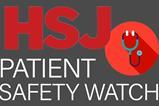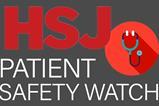HSJ hosts the Patient Safety Watch newsletter, written by Patient Safety Watch chief executive James Titcombe.
Good afternoon, and welcome to this fortnight’s edition of the Patient Safety Watch newsletter.
Scathing review prompts wider probe into patient safety bodies
After Penny Dash’s full report into the Care Quality Commission raised multiple serious concerns, health and social care secretary Wes Streeting commissioned Dr Dash to carry out two further reviews.
The first review will focus on patient safety and examine the roles of the six key patient safety organisations – the CQC, including the maternity programme, the National Guardian’s Office, Healthwatch England as well as the local Healthwatch network, the Health Services Safety Investigation Body, the Patient Safety Commissioner, and the quality and safety functions of NHS Resolution.
Mr Streeting said: “This government will never turn a blind eye to failure. An overly complex system of healthcare regulation and oversight is no good for patients or providers. We will overhaul the system to make it effective and efficient, to protect patient safety.”
Among Dr Dash’s recommendations for the CQC were a rapid improvement of operational performance, pausing assessments of integrated care systems, and improving clarity and transparency around how ratings were calculated.
CQC chair Ian Dilks said the regulator would “accept the findings and we will address the recommendations with urgency”, adding: “We are committed to rebuilding trust in CQC’s regulation and are taking action to make sure we have the right structure, processes and technology in place to help us fulfil our vital role of helping people get good care and supporting providers to improve.”
My view? In the 15 years I’ve been closely involved in the NHS’s patient safety landscape, I’m struck by the cyclical nature of problems and false dawns. I remember only too vividly in 2013 when the CQC was branded “not fit for purpose” and its leadership described as “totally dysfunctional” when a damning independent report into its handling of events at Morecambe Bay was published. The promise then was of lasting change.
Only 11 years later, it seems many of those lessons need to be learnt again. This mantra of “lessons have been learnt”, only for the same issues to repeat, is deeply damaging to public trust and harmful to everyone impacted by unsafe care.
The ambition for our NHS must be for it to be the world’s foremost learning organisation, yet the evidence (and we need look no further than the Thirlwall analysis of inquiry recommendations over the past 30 years), is that it remains an organisation with amnesia.
As we look at Dr Dash’s review’s findings, we mustn’t just focus on individual organisational shortcomings; we must also look at the overall system and the alignment of levers and incentives this system creates. The challenge for future reform must be to ensure these organisations (including professional regulators) work together to truly support safer care and to demonstrate accountability in ways that rebuild trust with the public and healthcare professionals alike.
In other news this edition…
CQC boss resigns
Kate Terroni, currently the CQC’s interim chief executive, has announced she is leaving the regulator.
She said: “At the beginning of September, I informed the chair of my decision to not apply for the permanent chief executive role, as I recognised the need for fresh leadership to take us forward.
“It has been a huge privilege to act as interim chief executive, but it has also been an intensely challenging experience, and I needed to take some time away to absorb the impact it has had on me.”
Ms Terroni took on the role after Ian Trenholm suddenly left the watchdog in June. Earlier this month, former NHS trust chief executive Sir Julian Hartley was announced as the CQC’s new substantive CEO.
Health secretary brands NHS delays a ‘death sentence’
Speaking alongside the prime minister at an event about the future of the NHS, Mr Streeting criticised the current state of delays in services, stressing they had led to tragic outcomes for some patients.
As reported by The Guardian, the health secretary said: “The NHS is going through what is objectively the worst crisis in its history, whether it’s people struggling to get access to their GP, dialling 999 and an ambulance not arriving in time, turning up to [accident and emergency] departments and waiting far too long, sometimes on trolleys in corridors, or going through the ordeal of knowing that you’re waiting for a diagnosis that could be the difference between life and death.
“Worse still, receiving a prognosis that amounts to a death sentence that could have been avoided, because the NHS didn’t reach you in time.”
Crumbling hospitals putting patient care at risk, say NHS bosses
According to an NHS Providers survey, shared with and reported on by the i, more than half of trust leaders say estates issues are either “severely” or “significantly” affecting their ability to deliver high-quality care.
NHS Providers deputy chief executive Saffron Cordery said: “This isn’t just about bricks and mortar. The wellbeing of patients and staff and ensuring high-quality care relies upon safe buildings and equipment. Eye-watering bills costing billions just to patch up creaking NHS buildings and equipment keep piling up.”
The findings came shortly after East Lancashire Hospitals Trust revealed it was shutting Accrington Victoria Community Hospital amid concerns it was “beyond repair”, adding its roof has collapsed, it is “full of asbestos”, and it is “dangerous to remain there”.
Family to receive up to £23m after baby born severely disabled
As reported in the Nottingham Post, a family is to receive up to £23m in compensation after their son was born severely disabled following failings at a local hospital.
The settlement – which was reached out of court – came after a High Court judge found there had been negligence in the care of the baby’s mother, who gave birth at City Hospital in 2004.
The mother was wrongly assured everything was fine following a scan in the late stages of pregnancy. However, her baby was born having suffered a brain injury caused by chronic partial hypoxia. The now 20-year-old man, who was born with cerebral palsy, needs round-the-clock care.
The mother has said she has had to “endure years of denial” from Nottingham University Hospitals. The trust’s medical director, Manjeet Shehmar, said she was “truly sorry” for the harm caused.
Sadly, readers of this newsletter will be only too aware that such cases are far from unique. More details of the government’s approach to addressing a worsening picture for maternity safety are urgently needed.
Report emphasises importance of therapeutic care in mental health units
HSSIB has published the first of its investigations into mental health inpatient settings, including recommendations to ensure therapeutic care is a priority.
The report recognises the increasing demand and pressure facing mental health services, adding that the current systems do not always support staff to deliver the therapeutic care needed to keep patients safe. The investigation also found risks relating to delivering safe and therapeutic care are not always fully understood or managed effectively.
Patient safety commissioner launches patient safety principles
Following a recent consultation exercise, patient safety commissioner Henrietta Hughes has published a set of seven patient safety principles. The principles are intended to advise leaders at all levels about designing and delivering safer care for patients and reducing avoidable harm through a just and learning culture. The principles are sensible and pragmatic and I was particularly pleased restorative practice was recommended as an approach leaders should adopt.
This newsletter has previously featured the harmed patient pathway project, an important initiative that promotes restorative practice in the approach healthcare organisations take in responding to patients and families following harm.
This week, the patient safety commissioner also urged Mr Streeting to expand her role. Speaking to HSJ, Ms Hughes said she wanted her remit to be expanded to cover “everything to do with keeping patients safe… and listening to patients’ voices”.
Sharing some good stuff…
Introducing SafetyNet – The NIHR Patient Safety Research Collaboration Network
Part of the National Institute for Health and Care Research Patient Safety Research Collaborations, SafetyNet is a newly launched network, providing a platform to share knowledge, resources, and expertise across the PSRCs. The collaborations are funded by the NIHR to lead research aimed at improving patient safety and reducing safety inequalities.
To stay up-to-date on its work, you can follow the network at SafetyNet on X (formerly Twitter) and subscribe to the quarterly newsletter.
Quality management system design – webinar
On Wednesday (30 October) at 12.30pm, Tom Rose will share his approach and insight on implementing a quality management system based on ISO 7101: 2023 in an NHS trust. It looks like a really interesting and very relevant event – I have signed up!
More information about the webinar and a link to register is available here.
Involvement in serious incident investigations: a qualitative documentary analysis of NHS trust policies in England
The final share for this edition is this newly published paper from McHugh, S., Louch, G., Ludwin, K. et al. The work highlights the gap in NHS policies around serious incident investigations when it comes to active involvement for those affected.
The work found that “involvement as a concept was conspicuous by its absence in policy documents”, while “direct reference to support or involvement of those affected by serious incidents was lacking”.
Important work and essential reading for patient safety teams and those working in engagement/family liaison roles.
That’s all for this edition. Please look out for our next newsletter in two weeks. Until then, thanks for reading and stay safe.
James Titcombe
































2 Readers' comments